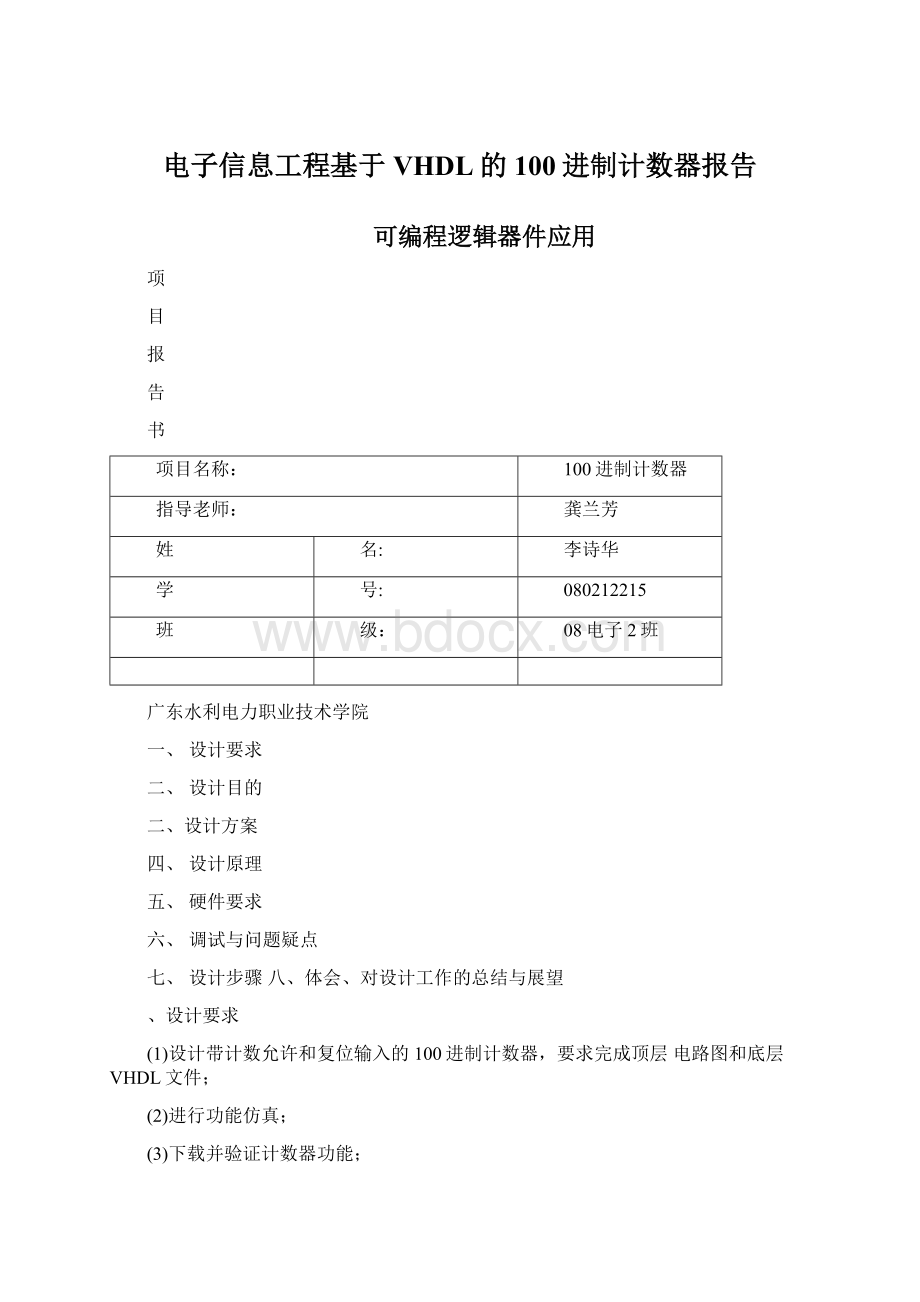电子信息工程基于VHDL的100进制计数器报告.docx
《电子信息工程基于VHDL的100进制计数器报告.docx》由会员分享,可在线阅读,更多相关《电子信息工程基于VHDL的100进制计数器报告.docx(6页珍藏版)》请在冰豆网上搜索。

电子信息工程基于VHDL的100进制计数器报告
可编程逻辑器件应用
项
目
报
告
书
项目名称:
100进制计数器
指导老师:
龚兰芳
姓
名:
李诗华
学
号:
080212215
班
级:
08电子2班
广东水利电力职业技术学院
一、设计要求
二、设计目的
二、设计方案
四、设计原理
五、硬件要求
六、调试与问题疑点
七、设计步骤八、体会、对设计工作的总结与展望
、设计要求
(1)设计带计数允许和复位输入的100进制计数器,要求完成顶层电路图和底层VHDL文件;
(2)进行功能仿真;
(3)下载并验证计数器功能;
(4)按上述步骤设计100进制计数器;
(5)为上述设计建立元件符号。
、设计目的
(1)设计一个带计数允许和复位端的100进制计数器。
(2)熟练掌握各种计数器类型模块的描述方法。
(3)能用计数器构成十进制、六十进制、十二进制等所需进制的计数器。
(4)体会EDA技术的优点。
设计两个按键,一个有停止、开始的功能,另一个有复位清零的功能,具体的看表1-1。
表1-1
按键
状态
功能
En
En=1
f开始计时
En=0
停止计时
Rst
Rst=0
复位清零
通过分频分出1KHZ对数码管的位地址进行扫描,而100KHZ利用if-else设计计数程序,并输出显示信号。
利用多个进程来完成以上的设计方案。
四、设计原理
libraryieee;
use
ieee.std_logic_1164.all;
use
ieee.std_logic_unsigned.all;
use
ieee.std_logic_arith.all;
entitybcd_100dis
port(en,rst,clk:
instd_logic;
duan:
outstd_logic_vector(5downto0);cout:
outstd_logic_vector(6downto0));
end;
architectureoneofbcd_100dis
signalclk_1k:
std_logic;
signalclk_100h:
std_logic;
signalcnt6:
integerrange0to3;
signaldata:
std_logic_vector(3downto0);
signaldata1:
std_logic_vector(3downto0);
signaldout:
std_logic_vector(5downto0);
signals:
std_logic_vector(6downto0);
signalled1,led2,led3,led4:
std_logic_vector(3downto0);
begin
process(clk)
variablecnt1:
integerrange0to250;
variablecnt2:
integerrange0to100;
begin
ifclk'eventandclk='1'then
ifcnt1=250thencnt1:
=0;
ifcnt2=100thencnt2:
=0;
clk_1k<=notclk_1k;
else
cnt2:
=cnt2+1;
endif;
else
cnt1:
=cnt1+1;
endif;
endif;
endprocess;
process(clk)
variablecnt1:
integerrange0to4000;
variablecnt2:
integerrange0to4000;
begin
ifclk'eventandclk='1'thenifcnt1=4000then
cnt1:
=0;
ifcnt2=4000then
cnt2:
=0;clk_100h<=notclk_100h;
else
cnt2:
=cnt2+1;
endif;
else
cnt1:
=cnt1+1;
endif;
endif;
endprocess;
process(clk_1k)
begin
ifclk_1k'eventandclk_1k='1'thenifcnt6=3then
cnt6<=0;
else
cnt6<=cnt6+1;
endif;
endif;
endprocess;
process(cnt6)
begin
casecnt6is
when0=>dout<="111110";
when1=>dout<="111101";
whenothers=>null;
endcase;
endprocess;
process(dout)
begin
casedoutis
when"111110"=>data<=led1;
when"111101"=>data<=led2;whenothers=>null;
endcase;
endprocess;
process(clk_100h)begin
ifrst='0'then
led2<="0000";led1<="0000";
elsifclk_100h'eventandclk_100h='1'then
ifen='1'then
caseled1is
when"1001"=>led1<="0000";
caseled2is
when"1001"=>
led2<="0000";
led1<="0000";
whenothers=>
led2<=led2+1;
endcase;
whenothers=>
led1<=led1+1;
endcase;
endif;
endif;
endprocess;
process(data)
begin
casedatais
when"0000"=>s<="0111111";--0
when"0001"=>s<="0000110";--1
when"0010"=>s<="1011011";--2
when"0011"=>s<="1001111";--3
when"0100"=>s<="1100110";--4
when"0101"=>s<="1101101";--5
when"0110"=>s<="1111101";--6
when"0111"=>s<="0000111";--7
when"1000"=>s<="1111111";--8
when"1001"=>s<="1101111";--9whenothers=>null;
endcase;
endprocess;
duan<=dout;
cout<=s;
end;
五、硬件要求
表2-1
六、调试与问题疑点问题疑点:
1.怎样实现两数码管同时显示.
2.怎样实现数字的循环.
调试:
1.编译无误,然后就对照自己所设计的功能按键状态(表1-1),看是否符合
设计结果要求•
2.检查无误,然后对自己规定的设计方案分配引脚(表2-1),进行编译无误,就下载到实验板上来验证设计效果•如果与自己的想法有出入,就要进行修改最后要达到自己的结果.
3.验证的结果与是否符合自己所规定的设计方案.
七、设计步骤八、体会、对设计工作的总结与展望
在这次设计实验中,我深刻地体会到思路清晰是十分行重要的,
从分频开始,到数码管显示,再到实现计数。
每一步都是非常重要的,
刚开始时我就遇到了:
怎样实现两数码管同时显示,怎样实现数字
的循环这两个问题思路也很模糊,但参考了大量的资料后,我的思路也就渐渐地清晰了,问题也解决了。
这使我明白了参考资料能使我们学到很多课堂上无法学到和知识。
我相信在以后的设计中,只要肯思考就一定会有突破。